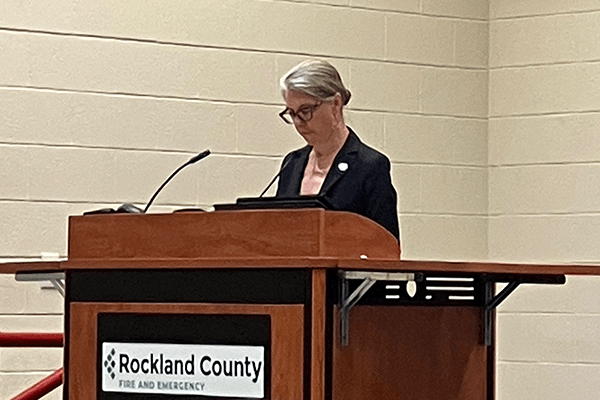|
RCBJ-Audible (Listen For Free)
|
Rockland County Lags Behind in State’s Ambition for 100,000 Affordable Units
NEWS ANALYSIS
New York State is focused on affordable housing opportunities, but Rockland County has more work to do.
RuthAnne Visnauskas, Commissioner of the New York State Office of Homes & Community Renewal (HCR), told a large crowd last week at the Third Annual Rockland County Housing Forum, that the clock is ticking. She said New York State is pouring millions of dollars into funding and finding affordable housing opportunities statewide. Rockland County’s track record to date is anemic, with only 14-state supported housing units built to date. However, she said many more are planned, mostly in the Village of Haverstraw.
Visnauskas talked about the success of the Governor’s Pro-Housing Communities, and how those participating municipalities could tap into millions of dollars of state money to support initiatives that promote housing growth and development within certified communities. Funds can be used to leverage and alleviate financial barriers associated with affordable housing development, making projects economically viable. The money can also be used for various infrastructure projects, site development, and placemaking investments that will increase the available housing supply.
What locals know is that four of the five towns (Ramapo being the only exception) and most of the County’s villages have declined to participate or even take the steps necessary to access the millions the state has set aside for local initiatives. Only the Villages of Haverstraw and Nyack are certified. Spring Valley and Kaser have submitted letters of intent. The rest of Rockland County has essentially cut themselves off from state funding opportunities, including funding for the Downtown Revitalization Initiative (DRI), the NY Forward program, the Regional Council Capital Fund, capital projects from the Market New York program, the New York Main Street program, and the Public Transportation Modernization Enhancement Program (MEP).
After the keynote speaker spoke, attendees broke into smaller groups to study issues like Fair Housing, Lead Hazard Remediation, and Grayfields (the Adaptive Reuse of Underutilized Spaces), Brownfields, Federal & State Housing Initiatives, and Rockland County’s Comprehensive Plan.
The Grayfields session, led by Neil Alexander, Esq. (Land Use Attorney with Cuddy & Feder, LLP), Adam Bosch (President & CEO of Hudson Valley Pattern For Progress) and Charlotte Abadir (Development Director with T&H Investments), covered the adaptive reuse of existing underutilized properties. (Grayfields differ from Brownfields, which are environmentally contaminated sites eligible for remediation tax credits.)
Rockland County is land-starved for new housing developments. Competition for available property for residential development is driving land costs higher, and regulatory and zoning restrictions stall new housing, which drives prices of existing homes beyond the reach of buyers looking for starter housing. The only exception to stalled development is market rate, senior housing.
The Grayfields speakers urged stakeholders to consider taking a new look at older, existing, under-utilized properties like closed schools, vacant big box stores, empty mall anchors, oversized parking lots, office campuses and municipal owned land. These sites have infrastructure in place – water, sewer, electric, road access – and wouldn’t impact existing open space, wooded areas, wetlands, and environmentally valuable parcels.
The solutions, according the speakers, was right at hand.
Rockland County has an abundance of Grayfield properties, from empty anchors at the Palisades Center (a shopping mall facing foreclosure and a likely sale), underutilized land at the Shops at Nanuet (recently sold by Simon Properties to a local developer), closed psychiatric centers (Letchworth, Rockland Psychiatric), closed schools in Congers, Garnerville, and Hillcrest. Also, privately-owned, but under-utilized parcels like the former HNA center in Palisades or the former Pfizer campus in Pearl River.
The problems, according to the speakers, lies with local government and outdated comprehensive plans, zoning codes and poorly functioning land-use boards. Comprehensive plans and zoning codes that prohibit or foreclose alternative uses for under-utilized properties stifle development. The problems also lie with local government officials misunderstanding the importance of PILOTs to developers. In most of the state, the local Industrial Development Authorities can approve and impose PILOT agreements on local government. But Rockland is unique — the IDA cannot impose a PILOT agreement. Developers must negotiate with local villages, towns and school districts, adding uncertainty, delay and politics into every new housing project seeking participation.
As Abadir demonstrated in her presentation, no matter how attractive a parcel, a developer would have second thoughts about a project if the zoning had to be changed to accommodate housing. The costs and delays could add years to a proposal that made sense for the community and the developer, but for the need to change the zoning.
The speakers also discussed the role of Planning Boards, and said that they are not arbiters of approval – their role is to comply with SEQRA (the State Environmental Quality Review Act) and ensure the project complies with the town’s codes. They say land-use boards are where projects go to die or be beaten into some reduced versions of the original plan to satisfy angry NIMBY constituents.
Takeaways from the Housing Forum:
- If we are serious about wanting to provide a housing future for new and existing residents, local governments must be pressured into participation and certification in the NYS Pro-Housing Community program. Without certification, local governments foreclose the opportunity to participate in the millions of dollars the state provides to support local initiatives.
- If we want to preserve remaining open space, wooded areas, wetlands, and environmentally sensitive areas in the County, we need to urge local government to rewrite their comprehensive plans and zoning codes to accomplish these goals.
- If we want to maximize our existing built environment through adaptive re-use of existing properties that are already served by existing infrastructure, local government needs to rezone commercial properties, including retail, laboratory, and office parks for residential use.
- If we want to tackle the land-use board obstacles, we need to streamline the processes, hold more frequent meetings, better train land-use board members, impose term limits, and clarify comprehensive plans.
- If we want to help developers control costs, secure financing, and provide some certainty for the future, we need to remove local discretion on PILOT programs and establish PILOT policies developers can rely on that they can access by meeting specific criteria.
Finally, what to do about NIMBY-ism and maintenance of the status quo. NIMBYs argue that increasing the supply of housing will decrease the resale value of the existing housing stock to their detriment. But Alexander said there is a cost to a community that chooses to do nothing about new housing options; and that doing nothing is seldom the right option. Communities need to grow to be sustainable. And, absent new residents, there is no one to share the ever increasing costs of simply existing.












